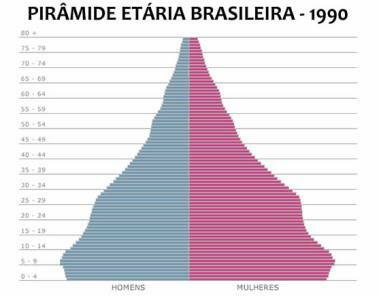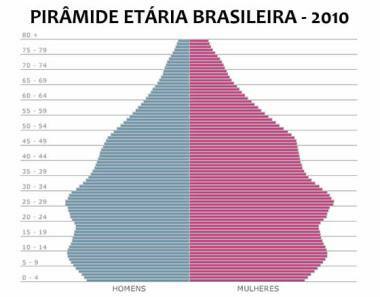The expression Age pyramid refers to a graph used to identify the population of a given country or region, grouping the inhabitants into age groups and dividing them by sex. The reason for this name comes from the fact that, when creating this type of information, all countries (even developed ones) had their population structured in a pyramidal format. Although this was no longer true, the expression remained.
Generally speaking, as countries develop, the pyramid shape breaks down, indicating a drop in birth and mortality rates. In other words, as a country develops, its population gets older.
With Brazil it is no different. Following what once happened with central or developed countries and following emerging nations (such as Mexico, Russia and South Africa), the base of the population pyramid Brazilian population has been decreasing, while the upper portion has been widening, indicating a drop in the birth rate and an increase in the quality and life expectancy of the population of the parents. Observe the population evolution between 1980 and 2010 in the graphs below:

In 1980, the younger population was predominant *

From the 1990s onwards, the population between 0 and 4 years of age has been decreasing *

In 2000, the older population increased considerably *

In the last Demographic Census, Brazil already has an adult population and no longer a young one *
Until the 1980s, Brazil was considered a young country, that is, the proportional number of people with lower age groups was relatively higher. However, currently, we are witnessing a process of maturation of the country's inhabitants and a consequent increase in the older population. Before, people over 80 years old was something extremely rare, nowadays it is becoming more and more common.
Why is the Brazilian population aging?
As we mentioned above, the Brazilian population is aging at the same pace as most from other developing countries, going through stages that developed nations have already experienced. This is due to the rising levels of urbanization and economic and human development in the country.
Throughout the 20th century, Brazil stopped being rural and became predominantly urban, currently presenting more than 85% of the population living in cities with more than 20,000 inhabitants, according to data from the Demographic Census of 2010. In addition, in 2009, for the first time, Brazil had an HDI (Human Development Index) considered high, that is, equal to or greater than 0.700 (on a scale of 0.000 to 1.000).
Recently, the country has also been registering high rates of economic growth compared to other economies in the world, representing an increase in GDP (Product Gross Domestic) and a consequent average increase in investments in health and education, although such expenses are still considered low by the standards international.
All these factors contribute to the increase in the population's increased life expectancy. Birth rates, in turn, tend to fall due to the increase in family planning and the inclusion of women in the labor market, among other reasons.
What is better for the country: being “young” or “old”?
It is not advantageous for any country to be too young, much less to be too old. This is explained by the fact that most of the Economically Active Population (EAP) is located in intermediate age groups. Thus, very high birth rates, for example, decrease the average age, overloading economically the adult population, a fact that intensifies when investments in education and health public are low.
On the other hand, when the population ages with the increase in life expectancy and there is a sudden decrease in birth rates, there is again an overweight on the PEA, since it is the taxes paid by this population that will maintain the social security and retirement of the most old people. It is worth mentioning that one day these elders also supported the retirees of their generation, so that their pension rights cannot be denied them.
Thus, it is always necessary to find a balance between the level of the population, which should preferably be keep as an adult, that is, neither too old nor too young, as is the case of the Brazilian population in present.
_______________________________
* Data: IBGE – Population Projection
By Rodolfo Alves Pena
Graduated in Geography
Source: Brazil School - https://brasilescola.uol.com.br/brasil/piramide-etaria-populacao-brasileira.htm
